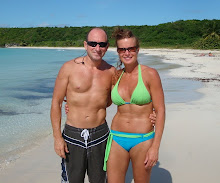Seaweed, lots of it. That's been the talk in the Caribbean since last year. If you peruse Caribbean news or blogs you'll no doubt run into discussions about the recent Sargassum seaweed invasion.
Lorrie and I ran into it last November:
It had most all the beaches, except for Sunbay and parts of Caracas, nearly unusable. Not only was it on the beaches, large masses of it were floating out in and around the island. This is not new. The Caribbean has had to deal with Sargassum seaweed in the past, just not in the amounts that have been occurring recently.
The Sargasso Sea is a 2,000,000-square-mile ellipse-shaped region of the North Atlantic Ocean extending south and east of Bermuda. It's called the Sargasso sea because comparatively large amounts of seaweed of the genus Sargassum can be seen floating on the surface. Although the ubiquitous seaweed might lead one to suppose the Sea to be an unusually fertile stretch of ocean--a marine jungle, as it were--its warm, still waters have actually long been considered something of a desert in biological terms, with relatively little life (except for the seaweed, of course). Like many deserts, though, it does harbor its own unique ecosystem, with organisms that are specially adapted to live among the Sargassum mats, and biologists have more recently begun to appreciate the region's potential as a haven of biodiversity. (Still no mermaids, though.)
The Sea's special properties are a result of it lying in the center of a huge oval of relatively still waters bounded by ocean currents, including the Gulf Stream, which circle it clockwise, sort of like the eye of a very huge, very, very slow, permanent hurricane.
Not only did Columbus encounter the Sargasso Sea, he is credited with its discovery, being the first person to leave an account of it. Columbus, ever the optimist, took the seaweed as a sign that he was close to shore. (In fact, the Sea lies many hundreds of miles from land, except for the tiny Bermuda Islands in its northwestern quadrant.) His sailors, on the other hand, reputedly first vented the oft-expressed fear of becoming entangled in the seaweed.
The Sargasso Sea went on to figure prominently in nautical lore as a place where ships would become entangled by the seaweed, and if you look for information on the Sargasso, be prepared to find a lot of silliness about the "mysterious" Bermuda Triangle. It's all a lot of hooey, though. Although there's more of it in the Sargasso Sea than in some randomly chosen patch of ocean elsewhere, the seaweed there has never been remotely thick enough to hamper a ship from sailing through. A ship could no more be "stuck" in the Sargasso Sea than it could be "stuck" in any other part of the ocean. A fact which undoubtedly added to the popularity of the "ships tangled in seaweed" legend is that the same patterns of currents which form the Sargasso Sea also lead to it being part of the area known as the "doldrums" or the "horse latitudes." Because the winds and currents are relatively calm there, sailing ships frequently found themselves becalmed--trapped not by the humble seaweed but by a lack of wind. Modern ships, of course, are no longer at the mercy of the winds that way, and jetliners are even less so.
There are a lot of questions as to why the recent invasion of seaweed. Climate change, pollution, over fishing and coastal development are just some of the reasons being evaluated.
:-)





I will post some pictures of beaches at the end of the month. We hope by then the seaweed will be gone.
ReplyDeleteDid not have much problem with sea weed just a little on the west end of Blue beach. Some on the North beaches.
Delete